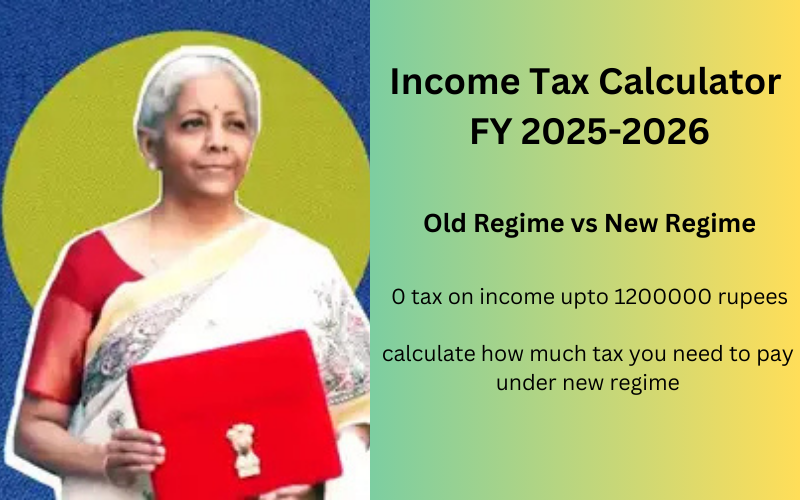Income Tax Calculator (Old vs New Regime)
Understanding the Difference Between the New and Old Tax Regime in India
With the recent changes in the Income Tax Regime introduced in the 2025 Budget, many taxpayers are unsure about which tax regime is best for them – the Old Regime or the New Regime. In this blog, we’ll break down the differences between these two regimes, explain how each tax regime works, and provide a clear example to help you decide which one suits your needs.
What is the Old Tax Regime?
The Old Tax Regime is the traditional system in which taxpayers can claim deductions and exemptions, including but not limited to:
- Standard deduction (₹50,000)
- 80C deductions (e.g., PPF, EPF, ELSS)
- Home loan interest deductions
- Tax-saving investments
This system allows individuals to optimize their taxable income through various deductions, thereby reducing the overall tax liability. However, it involves a more complex process since taxpayers need to track and calculate their eligible deductions and exemptions.
Old Tax Slabs:
The Old Tax Regime uses the following income slabs:
- Up to ₹2,50,000: No tax
- ₹2,50,001 to ₹5,00,000: 5% tax
- ₹5,00,001 to ₹10,00,000: 20% tax
- Above ₹10,00,000: 30% tax
Additionally, you can claim tax-saving deductions, further reducing your taxable income.
What is the New Tax Regime?
Introduced in 2020, the New Tax Regime aims to simplify the tax process by offering reduced tax rates but without any exemptions or deductions, except for a standard deduction of ₹50,000.
The key idea behind this regime is to provide taxpayers with a lower tax rate on their income in exchange for giving up the ability to claim various deductions and exemptions. It’s designed for those who do not wish to spend time managing their investments and deductions.
New Tax Slabs:
Here are the progressive tax slabs under the New Tax Regime:
- Up to ₹12,00,000: No tax
- ₹12,00,001 to ₹16,00,000: 15% tax
- ₹16,00,001 to ₹20,00,000: 20% tax
- ₹20,00,001 to ₹24,00,000: 25% tax
- Above ₹24,00,000: 30% tax
Key Differences Between the Old and New Tax Regimes
- Tax Slabs:
- In the Old Regime, the tax rate starts at 5% for income above ₹2,50,000 and rises to 30% for income over ₹10,00,000.
- The New Regime offers a 0% tax rate for income up to ₹12,00,000, with rates increasing progressively based on income brackets, going up to 30% for income above ₹24,00,000.
- Deductions and Exemptions:
- Old Regime: You can claim several deductions like those under Section 80C, 80D, and 80E, etc., to reduce your taxable income.
- New Regime: There are no deductions or exemptions except for the standard deduction of ₹50,000.
- Complexity:
- The Old Regime involves more paperwork and tracking of eligible deductions, making it more complex for taxpayers.
- The New Regime is simpler as it does not require tracking of deductions and exemptions, making it ideal for individuals who prefer a straightforward tax calculation.
Which Tax Regime Should You Choose?
The choice between the Old and New Regime largely depends on your income level and whether you’re able to claim sufficient deductions. Let’s break it down with an example:
Example:
Let’s say an individual has an annual income of ₹15,00,000.
Under the Old Regime:
- Standard Deduction: ₹50,000
- After the standard deduction, the taxable income becomes ₹14,50,000.
- The tax calculation will be:
- ₹2,50,000 to ₹5,00,000: 5% → ₹12,500
- ₹5,00,001 to ₹10,00,000: 20% → ₹1,00,000
- ₹10,00,001 to ₹14,50,000: 30% → ₹1,35,000
- Total Tax: ₹12,500 + ₹1,00,000 + ₹1,35,000 = ₹2,47,500
Under the New Regime:
- Standard Deduction: ₹50,000
- After the standard deduction, the taxable income becomes ₹14,50,000.
- The tax calculation will be:
- ₹12,00,000 to ₹14,50,000: 15% → ₹37,500
- ₹14,50,001 to ₹16,00,000: 20% → ₹0 (since income is less than ₹16,00,000)
- Total Tax: ₹37,500 (with no deductions except for the standard ₹50,000)
In this case, the Old Regime would result in a higher tax of ₹2,47,500 compared to the New Regime tax of ₹37,500.
When Should You Choose the Old Regime?
- Claiming Deductions: If you have a lot of deductions (like investments in PPF, ELSS, or a home loan), the Old Regime may work better for you.
- Income with a Significant Portion of Tax-Saving Investments: The Old Regime may be more beneficial if you’re able to invest and claim deductions.
When Should You Choose the New Regime?
- No Tax-Saving Investments: If you don’t have many investments or if tracking them is inconvenient, the New Regime offers a simpler, straightforward tax calculation.
- Lower Taxable Income: If your income is not very high, the New Regime might result in lower tax due to lower slabs.
Final Thoughts
The choice between the Old Regime and New Regime depends on your specific financial situation, including your income and eligibility for deductions. If you have significant tax-saving investments, the Old Regime may still offer you better tax savings. However, if you prefer simplicity and don’t want to worry about managing deductions, the New Regime could be a better choice.
Always consider consulting a tax professional or using an online Income Tax Calculator to determine which regime is the most tax-efficient for your circumstances.
